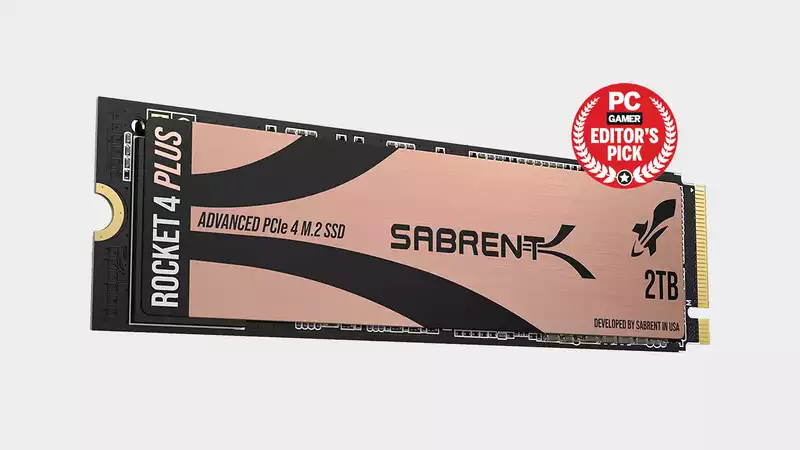Sabrent Rocket 4 Plus is the first drive to use the new Phison E18 controller. This follows the immensely popular Phison E16 controller found in most first-generation PCIe 4.0 drives, from the Corsair MP600 to the Gigabyte Aorus, Addlink S90, and many drives from Sabrent.
This first generation of PCIe 4.0 controllers was everywhere because of its throughput. It recorded just over 5,000 MB/sec read and 4,400 MB/sec write, compared to the best PCIe 3.0 drives at 3,500 MB/sec read and just 2,500 MB/sec write.
The new Phison E18 controller raises that bar significantly, delivering up to 7,100MB/s read and 6,600MB/s write sequential throughput. These numbers are not far off from the speeds that can be expected from PCIe 4.0, since the theoretical limit for both interfaces is 8GB/s. Basically, it is incredibly fast and, at least on paper, the fastest drive ever released.
To achieve these numbers, you will need a platform that supports PCIe 4.0, i.e., a CPU and motherboard that supports the latest PCIe 4.0 interface. At the moment, the limit is a Ryzen 3000 or Ryzen 5000 CPU on an X570 or B550 motherboard. Intel will soon enter the ultra-fast storage game with Rocket Lake, which is expected to arrive in March. [Its Rocket brand has moved storage forward on many fronts, including lowering prices and producing QLC drives like the Rocket Q that don't actually suck thanks to clever use of SLC and RAM caches.
Returning to the Sabrent Rocket 4 Plus, the model I'm looking at here is a higher capacity 2TB drive priced at $400; the 1TB version is $199, but performance is also slower at 7,000MB/s read and 5,300MB/s write. At $0.20 per gigabyte, both are very competitive for new drives. Other next-generation drives we have seen so far are the Samsung 980 Pro at $0.30/GB and the WD Black SN850 at $0.23/GB.
Sabrent offers a 5-year warranty, which is now standard, as long as you register at the time of drive purchase. This corresponds to 1,400 total bytes written (TBW), which is well beyond what can reasonably be managed within this warranty period; in addition to the Phison controller, Sabrent also offers Micron NAND flash, SK Hynix RAM for cache and other well-known components throughout, so there should be basically no problems with this drive.
Aside from a small drive in a cigar case that is too cute to throw away after installation, there is not much else physically in the package. However, there is a download link for Acronis True Image to help you migrate your current installation, and the Sabrent Rocket Control Panel tells you the health of the drive; it's not on the same level as Samsung's Drive Magician or Western Digital s Dashboard, but it covers everything you need in a concise manner.
Performance is where Sabrent's latest drive impresses with little difficulty, especially when it comes to synthetic throughput. The sequential read and write numbers in both benchmarks are impressive, but it is the write performance that stands out the most, leaving the competition in the dust. The Samsung 980 Pro in particular really struggles to keep up with the Sabrent Rocket 4 Plus.
As we have seen with previous drives, this synthetic throughput does not always translate to the real world, and this is partially the case again: a 30 GB file (a Steam game installation, consisting of many small files and several huge) is competitive at 2 minutes and 16 seconds (equivalent to 225 MB/second) for a copy of
In PCMark 10 storage tests, the Sabrent lagged behind the Samsung 980 Pro and WD Black SN850 in both full and quick benchmarks. In the Final Fantasy XIV: Shadowbringers benchmark, the level load took just over 7.5 seconds, lagging behind the WD Black SN850 but clearly faster than the first-generation drive.
This is still a fast drive, no doubt, but despite the promise of best-in-class synthetic read and write speeds, it does not quite reflect best-in-class real-world performance. For everyday gaming applications, however, it has to settle for second best. [There is the question of how Microsoft's DirectStorage will impact next-generation SSD usage. This technology is already in the Xbox Series S/X and will be in Windows this spring, but it may take a little longer for game developers to really get the most out of this new technology. However, it will likely be some time before game developers can really take full advantage of this new technology. Until then, it is reasonable to focus on current performance, and this drive is definitely at the highest level.
If you are looking for the best performance, the WD Black SN850 has the edge over this drive. However, this drive has a higher operating temperature than the Sabrent Rocket 4 Plus, as much as 12°C higher, so we recommend this drive for tight cases. Also, this drive is $50 less than the 2TB WD Black SN850, making this drive a better value.
.

Comments